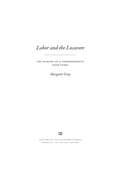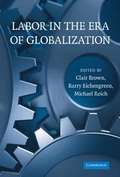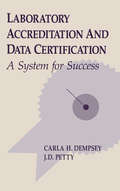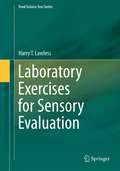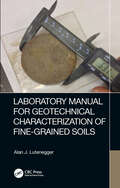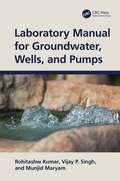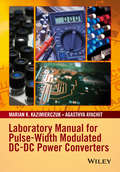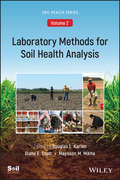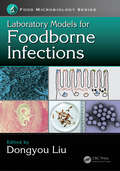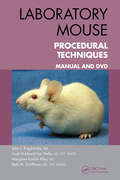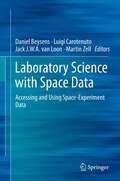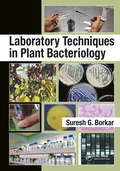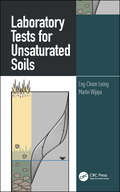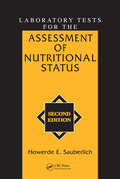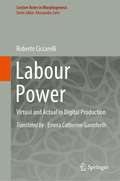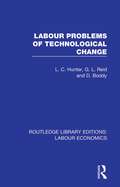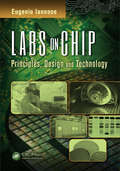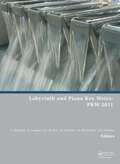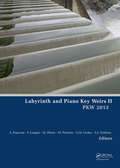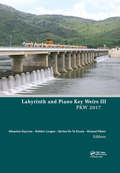- Table View
- List View
Labor and the Locavore
by Margaret GrayIn the blizzard of attention around the virtues of local food production, food writers and activists place environmental protection, animal welfare, and saving small farms at the forefront of their attention. Yet amid this turn to wholesome and responsible food choices, the lives and working conditions of farmworkers are often an afterthought.Labor and the Locavore focuses on one of the most vibrant local food economies in the country, the Hudson Valley that supplies New York restaurants and farmers markets. Based on more than a decade's in-depth interviews with workers, farmers, and others, Gray's examination clearly shows how the currency of agrarian values serves to mask the labor concerns of an already hidden workforce. She also explores the historical roots of farmworkers' predicaments and examines the ethnic shift from Black to Latino workers. With an analysis that can be applied to local food concerns around the country, this book challenges the reader to consider how the mentality of the alternative food movements implies a comprehensive food ethic that addresses workers' concerns.
Labor in the Era of Globalization
by Clair Brown Barry Eichengreen Michael ReichThe third quarter of the twentieth century was a golden age for labor in the advanced industrial countries, characterized by rising incomes, relatively egalitarian wage structures, and reasonable levels of job security. The subsequent quarter-century has seen less positive performance along a number of these dimensions. This period has instead been marked by rapid globalization of economic activity that has brought increased insecurity to workers. The contributors to this volume, prominent scholars from the United States, Europe, and Japan, distinguish four explanations for this historic shift. These include 1) rapid development of new technologies; 2) global competition for both business and labor; 3) deregulation of industry with more reliance on markets; and 4) increased immigration of workers, especially unskilled workers, from developing countries. In addition to analyzing the causes of these trends, the contributors also investigate important consequences, ranging from changes in collective bargaining and employment relations to family formation decisions and incarceration policy.
Laboratory Accreditation and Data Certification: A System for Success
by Carla H. Dempsey Jimmie D. PettyThis book provides descriptions of current laboratory accreditation schemes and explains why these schemes fall short of assuring data purchasers that the data produced from accredited laboratories are always quality products. The book then presents a system for laboratory accreditation in conjunction with data certification that assures data purchasers their data are useful for the purposes for which they are intended. Simple quality assurance and quality control techniques, in addition to concepts of total quality management, are described and then applied to the environmental laboratory industry. This "System For Success" was developed from real problems and real solutions within the industry and represents an integration of proven techniques that offer a better way to ensure quality laboratory data is obtained. Laboratory Accreditation: A Workable Solution is a must for government officials, environmental professionals, independent environmental laboratories, hazardous waste disposal industries, chemical manufacturers, QA professionals, and testing laboratories.
Laboratory Design, Construction, and Renovation: Participants, Process, and Product
by Committee on Design Construction Renovation of Laboratory FacilitiesLaboratory facilities are complex, technically sophisticated, and mechanically intensive structures that are expensive to build and to maintain. Hundreds of decisions must be made before and during new construction or renovation that will determine how successfully the facility will function when completed and how successfully it can be maintained once put into service. This book provides guidance on effective approaches for building laboratory facilities in the chemical and biochemical sciences. It contains both basic and laboratory-specific information addressed to the user community-the scientists and administrators who contract with design and construction experts. The book will also be important to the design and construction communities-the architects, laboratory designers, and engineers who will design the facility and the construction personnel who will build it-to help them communicate with the scientific community for whom they build laboratory facilities.
Laboratory Exercises for Sensory Evaluation
by Harry T. LawlessLaboratory exercises are a necessary part of science education. They enable students to better understand the principles discussed in lectures, and provide them with hands-on experience of the practical aspects of scientific research. The purpose of this book is to provide students and instructors with a time-tested set of lab exercises that illustrate the common sensory tests and/or sensory principles used in evaluation of foods, beverages and consumer products. The appendices will also include a set of simple problem sets that can be used to teach and reinforce basic statistical tests. Approximately twenty years ago the Sensory Evaluation Division of the Institute of Food Technologists sponsored the preparation of a set of exercises titled "Guidelines for Laboratory Exercises for a Course in Sensory Evaluation of Foods," edited by one of the co-authors (Heymann). This book will provide additional materials from the second author (Lawless), as well as other instructors, in a uniform format that can be easily adopted for course use. Most importantly, the lab exercises will complement the flagship textbook in the field, Sensory Evaluation of Foods: Principles and Practices, 2E, also by Lawless and Heymann and published by Springer. Possible course adoption of the main text along with the lab manual should enhance the sales of these materials.
Laboratory Guide for Conducting Soil Tests and Plant Analysis
by Jr., J. JonesWith the help of this guide, you can use obtained test results to evaluate the fertility status of soils and the nutrient element status of plants for crop production purposes. It serves as an instructional manual on the techniques used to perform chemical and physical characteristic tests on soils. Laboratory Guide for Conducting Soil Tests and Pl
Laboratory Manual for Geotechnical Characterization of Fine-Grained Soils
by Alan J. LuteneggerThis manual presents procedures for performing advanced laboratory tests on fine-grained soils. It covers characterization tests, which determine soil composition and quantify the individual components of a soil, and behavioral tests, such as the Atterberg Limits tests that demonstrate how the fines fraction of a soil reacts when mixed with water and the Linear Shrinkage Test that demonstrates how much a soil shrinks. The material goes beyond traditional evaluation of basic soil behavior by presenting more advanced laboratory tests to characterize soil in more detail. These tests provide detailed compositional characteristics which identify subtle changes in conditions and vertical variations in the soil, and which help to explain unusual behavior. A unique compilation of information on key soil tests Combines characterization tests with behavior tests The book suits graduate students in geotechnical engineering, as well as practitioners and researchers.
Laboratory Manual for Groundwater, Wells, and Pumps
by Vijay P. Singh Rohitashw Kumar Munjid MaryamThe over-exploitation of groundwater and marked changes in climate over recent decades has led to unacceptable declines in groundwater resources. Under the likely scarcity of available water resources in the near future, it is critical to quantify and manage the available water resources. With increasing demand for potable water for human consumption, agriculture, and industrial uses, the need to evaluate the groundwater development, management, and productivity of aquifers also increases. Laboratory Manual for Groundwater, Wells, and Pumps serves as a valuable resource and provides a multi-disciplinary overview for academics, administrators, scientists, policymakers, and professionals involved in managing sustainable groundwater development programs. It includes practical guidance on the measurement of groundwater flow, soil properties, aquifer properties, wells and their design, as well as the latest state-of-the-art information on pumps and their testing, and groundwater modeling. Features: Covers basics of groundwater engineering, advanced methodologies, and their applications and groundwater modeling Examines groundwater exploration, planning and designing, and methods for formulating strategies for sustainable management and development Serves as a reference for practitioners on practical applications and frequently occurring issues of groundwater investigations, development, and management.
Laboratory Manual for Pulse-Width Modulated DC-DC Power Converters
by Marian K. Kazimierczuk Agasthya AyachitDesigned to complement a range of power electronics study resources, this unique lab manual helps students to gain a deep understanding of the operation, modeling, analysis, design, and performance of pulse-width modulated (PWM) DC-DC power converters. Exercises focus on three essential areas of power electronics: open-loop power stages; small-signal modeling, design of feedback loops and PWM DC-DC converter control schemes; and semiconductor devices such as silicon, silicon carbide and gallium nitride. Meeting the standards required by industrial employers, the lab manual combines programming language with a simulation tool designed for proficiency in the theoretical and practical concepts. Students and instructors can choose from an extensive list of topics involving simulations on MATLAB, SABER, or SPICE-based platforms, enabling readers to gain the most out of the prelab, inlab, and postlab activities. The laboratory exercises have been taught and continuously improved for over 25 years by Marian K. Kazimierczuk thanks to constructive student feedback and valuable suggestions on possible workroom improvements. This up-to-date and informative teaching material is now available for the benefit of a wide audience. Key features: * Includes complete designs to give students a quick overview of the converters, their characteristics, and fundamental analysis of operation. * Compatible with any programming tool (MATLAB, Mathematica, or Maple) and any circuit simulation tool (PSpice, LTSpice, Synopsys SABER, PLECS, etc. ). * Quick design section enables students and instructors to verify their design methodology for instant simulations. * Presents lab exercises based on the most recent advancements in power electronics, including multiple-output power converters, modeling, current- and voltage-mode control schemes, and power semiconductor devices. * Provides comprehensive appendices to aid basic understanding of the fundamental circuits, programming and simulation tools. * Contains a quick component selection list of power MOSFETs and diodes together with their ratings, important specifications and Spice models.
Laboratory Methods for Soil Health Analysis (ASA, CSSA, and SSSA Books #192)
by Douglas L. Karlen Diane E. Stott Maysoon M. MikhaLaboratory Methods for Soil Health Analysis Analyzing, comparing, and understanding soil health data The maintenance of healthy soil resources is instrumental to the success of an array of global efforts and initiatives. Whether they are working to combat food shortages, conserve our ecosystems, or mitigate the impact of climate change, researchers and agriculturalists the world over must be able to correctly examine and understand the complex nature of this essential resource. These new volumes have been designed to meet this need, addressing the many dimensions of soil health analysis in chapters that are concise, accessible and applicable to the tasks at hand. Soil Health, Volume Two: Laboratory Methods for Soil Health Analysis provides explanations of the best practices by which one may arrive at valuable, comparable data and incisive conclusions, and covers topics including: Sampling considerations and field evaluationsAssessment and interpretation of soil-test biological activity Macro- and micronutrients in soil quality and health PLFA and EL-FAME indicators Offering a practical guide to collecting and understanding soil health data, this volume will be of great interest to all those working in agriculture, private sector businesses, non-governmental organizations (NGOs), academic-, state-, and federal-research projects, as well as state and federal soil conservation, water quality and other environmental programs.
Laboratory Models for Foodborne Infections (Food Microbiology)
by Dongyou Liu Laszlo EndrenyiResulting from ingestion of inappropriately prepared or stored foods containing pathogenic viruses, bacteria, fungi and parasites, foodborne infections have become a significant source of human morbidity and mortality worldwide in recent decades. This may be largely attributable to the remarkable popularity of convenient, ready-to-eat food products, the dramatic expansion of international food trades, and the continuing growth of immuno-suppressed population groups. Although anti-microbial treatments have played a crucial part in the control of foodborne infections in the past, the emergence and spread of anti-microbial resistance render the existing treatments ineffective. Additionally, our limited understanding of the molecular mechanisms of foodborne infections has thwarted our efforts in the development of efficacious vaccines for foodborne pathogens. Given the obvious benefits of laboratory models in foodborne disease research, a great number of experiments have been conducted toward the elucidation of host-pathogen interactions in and pathogenic mechanisms of foodborne infections. Forming part of the Food Microbiology series, Laboratory Models for Foodborne Infections presents a state-of-the-art review of laboratory models that have proven valuable in deciphering the life cycle, epidemiology, immunobiology, and other key aspects of foodborne pathogens. Written by scientists with respective expertise in foodborne pathogen research, each chapter includes a contemporary summary of a particular foodborne viral, bacterial, fungal, or parasitic infection in relation to its life cycle, epidemiology, clinical features, pathogenesis, host-pathogen interactions, and other related aspects. Besides providing a trustworthy source of information for undergraduates and postgraduates in food microbiology, Laboratory Models for Foodborne Infections offers an invaluable guide for scientists and food microbiologists with interest in exploiting laboratory models for detailed study of foodborne infections.
Laboratory Mouse Procedural Techniques: Manual and DVD
by John J. Bogdanske Scott Hubbard-Van Stelle Margaret Rankin Riley Beth SchiffmanThis combination manual and DVD provides much-needed training on the proper handling of mice used in biomedical research. The DVD includes narrated video clips that demonstrate and describe each procedural technique. The manual contains handouts with color illustrations and descriptive text for each technique, including the purpose and application
Laboratory Science with Space Data
by Martin Zell Luigi Carotenuto Jack J.W.A. van Loon Daniel BeysensFor decades experiments conducted on space stations like MIR and the ISS have been gathering data in many fields of research in the natural sciences, medicine and engineering. The EU-sponsored Ulisse Internet Portal provides metadata from space experiments of all kinds and links to the data. Complementary to the portal, this book will serve as handbook listing space experiments by type of infrastructure, area of research in the life and physical sciences, data type, what their mission was, what kind of data they have collected and how one can access this data through Ulisse for further research. The book will provide an overview of the wealth of space experiment data that can be used for research, and will inspire academics (e.g. those looking for topics for their PhD thesis) and research departments in companies for their continued development.
Laboratory Techniques for Fish Disease Diagnosis
by Vikash Kumar Basanta Kumar DasThis book covers various aspects of fish health, disease identification and laboratory procedures. Each section of the book is detailed and includes practical information, step-by-step procedures and relevant illustrations and diagrams. The recent updates on fish disease diagnosis have been incorporated to address new techniques and technologies in the field. Fish disease diagnosis is primarily based on the color and characteristics in the image to target the infected area. It is an indispensable part of modern aquaculture, and rapid and real-time diagnosis is an essential part of the early and precise treatment of the diseases. As farmed fishes are affected by viruses, bacteria, parasites, metal pollution, and fishing damage, accurate disease diagnosis is crucial for effective management interventions. It often requires a combination of clinical expertise, advanced technology, and collaboration among healthcare professionals. This book is a comprehensive guide for students, researchers and professionals involved in fish disease diagnosis.
Laboratory Techniques in Plant Bacteriology
by Suresh G. BorkarLaboratory Techniques in Plant Bacteriology is ideal for scientists and students who seek a career in plant pathogenic bacteria. This book contains 41 chapters comprising practicable techniques from isolation of bacterial plant pathogens to their identification up to species and race/biotype level. It includes identification protocols of morphological, biochemical, immunological, and molecular-based techniques. This book comprises all technological aspects of plant bacteriological studies. Its content is ideal for graduate students and research scholars including bacteriological professionals or technicians. The book ultimately provides working technologies useful for controlling bacterial disease pathogens.
Laboratory Tests for Unsaturated Soils
by Eng-Choon Leong Martin WijayaThe testing of unsaturated soils requires greater care and effort than that of saturated soils. Although unsaturated soil mechanics has been embraced by geotechnical engineering, engineering practice has not yet caught up as the characterization of unsaturated soils is difficult and time-consuming, and made harder still by a lack of standards. Laboratory Tests for Unsaturated Soils collates test procedures to cover all laboratory tests for characterising unsaturated soils. It covers the background, theory, test procedures, and interpretation of test results. Each test procedure is broken down into simple stages and described in detail. The pitfalls of each test and the interpretation of the test results are explained. Test data and calculation methods are given, along with many numerical examples to illustrate the methods of interpretation and to offer the presentation of typical results. The book is especially useful for students and researchers who are new to the field and provides a practical handbook for engineering applications.
Laboratory Tests for the Assessment of Nutritional Status (Modern Nutrition Ser. #21)
by Howerde E. SauberlichProper nutrition is the single most important component of preventative health care. Heart disease, diabetes, and other ailments are all linked to dietary habits. Accurate nutritional assessment can be a matter of life or death. Laboratory Tests for the Assessment of Nutritional Status explores the expanded number of nutrients that can now be evaluated. The author makes a compelling case for the practice and advancement of this critical health care tool. Nutritional assessment identifies undernutrition, overnutrition, specific nutrition deficiencies, and imbalances. Diligent assessment determines the appropriate nutrition intervention and monitors its effects. This book is a total revision of the 1974 version of the same title co -authored by Sauberlich. Since then, remarkable progress has been made on the methodologies applicable to nutrition status assessment and to the expanded number of nutrients that can be evaluated, especially trace elements. The introduction of high-performance liquid chromatography, amperometric detectors, and other technologies has advanced nutritional assessment by leaps and bounds. Today, nutritionists can gauge the value of microminerals, trace elements, and ultratrace elements. Sauberlich's revision updates the reader to the latest and most important trends in nutrition. These laboratory methods for the assessment of nutritional status are vital for identifying individuals as well as populations with nutritional risks.
Labour Power: Virtual and Actual in Digital Production (Lecture Notes in Morphogenesis)
by Roberto CiccarelliThis book offers a critical account of Karl Marx’s dazzling theory of labour power which is also one of the most influential concepts in the history of contemporary philosophy. Labour power is the dark side of the digital revolution. Working men and women are invisible and treated like human service, flesh and blood automatons or organic extensions of a machine that produces data on its own. Automation is viewed as something magic made possible by algorithms whose life is independent of human beings.Labour power, however, has not disappeared. Without drivers, Uber cannot connect customers on its platform; without searches on its browser, Google grinds to a halt; without us, Facebook or Instagram is desert. Labour power is the dwarf hidden inside the puppet of technology that allows algorithms to be intelligent and make the biggest profits in the history of capitalism.The invisible centrality of labour power is the political enigma of our times. Today a new account of the theory of labour power is needed more than ever in order to understand the political economy of digital capitalism on new grounds. Unlike a long tradition in the history of work, labour power is not only the work or the data it produces, but a potency that does not coincide with its current commodification. The actuality of labour power does not exhaust the virtuality that can be actualised by its faculty. Even when reduced to a commodity, labour power does not exhaust the potency of its being otherwise.Immersed in the constant propaganda that boosts the latest technological inventions, we neglect the fact that this wealth is produced by us and that it could be ours precisely because it is a part of our potential to be other than what we are at present. This book is a vibrant invitation to consider the fact that we are always connected with the potency that is constantly at work in our life. If this were not the case, we would not be alive. If we do not strive to become consciously and collectively active, we will never know.
Labour Problems of Technological Change (Routledge Library Editions: Labour Economics #8)
by L. C. Hunter G. L. Reid D. BoddyFirst published in 1970. This book is concerned with the examination and assessment of the impact of changes in technology on companies in three selected industries: printing, steel and chemicals. Its main focus is on the employment and associated labour market effects of technological change; but part of the rationale for the study as a whole has been to relate these effects to the technological environment of each industry. Accordingly, a good deal of attention has been paid to the character of the innovations themselves and to their implications for the industries in general terms. This title will be of interest to students of Business Studies and Economics.
Labs of Our Own: Feminist Tinkerings with Science
by Sig / GiordanoFrom climate change to COVID-19 to reproductive justice, there has been deep political polarization around science. Labs of Our Own provides a unique entry point into these twenty-first-century science wars by focusing on our affective relationships to science. The book delves into various sites where scientists, teachers, artists, and activists claim to create more democratic access to science—from DIY biology community labs to feminist classrooms to activist science practitioners. The reader will find that these claims for and attempts at democratic sciences not only impact what counts as science and who counts as a scientist but reconfigure who is included in the proper public. Instead of arguing for a knee-jerk defense of science against right-wing attacks, Labs of Our Own builds the case for a feminist, antiracist, decolonial, queer science tinkering practice that intentionally, politically, and ethically acts to produce new challenges to the definition and boundaries of the human.
Labs on Chip: Principles, Design and Technology (Devices, Circuits, and Systems)
by Eugenio IannoneLabs on Chip: Principles, Design and Technology provides a complete reference for the complex field of labs on chip in biotechnology. Merging three main areas— fluid dynamics, monolithic micro- and nanotechnology, and out-of-equilibrium biochemistry—this text integrates coverage of technology issues with strong theoretical explanations of design techniques. Analyzing each subject from basic principles to relevant applications, this book: Describes the biochemical elements required to work on labs on chip Discusses fabrication, microfluidic, and electronic and optical detection techniques Addresses planar technologies, polymer microfabrication, and process scalability to huge volumes Presents a global view of current lab-on-chip research and development Devotes an entire chapter to labs on chip for genetics Summarizing in one source the different technical competencies required, Labs on Chip: Principles, Design and Technology offers valuable guidance for the lab-on-chip design decision-making process, while exploring essential elements of labs on chip useful both to the professional who wants to approach a new field and to the specialist who wants to gain a broader perspective.
Labyrinth and Piano Key Weirs
by Sébastien Erpicum Michel Pirotton Frédéric Laugier Jean-Louis Boillat Bernard Reverchon Anton SchleissLabyrinth spillways are almost as old as dam engineering. In spite of the fact that they appear as a very good technical-economical compromise, only 0.1% of large dams are equipped with such weirs. The main reason for this is that traditional labyrinth weirs usually cannot be installed on top of concrete gravity dams as they require a large foundat
Labyrinth and Piano Key Weirs II
by Sébastien Erpicum Michel Pirotton Michael Pfister Frédéric Laugier Guy-Michel Cicero Anton J. SchleissDam engineering is currently experiencing a strong revival of labyrinth oriented weirs. Labyrinth weirs, with a repetitive constructional character and an increased specific discharge capacity, are a very good technical-economical compromise. The concept of Piano Key Weir (PKW), with alveoli developed in overhangs from a reduced support area, enabl
Labyrinth and Piano Key Weirs III: Proceedings of the 3rd International Workshop on Labyrinth and Piano Key Weirs (PKW 2017), February 22-24, 2017, Qui Nhon, Vietnam
by Sébastien Erpicum Michael Pfister Frédéric Laugier Michel Ho Ta KhanhSince the first implementation by Electricité de France on the Goulours dam (France) in 2006, the Piano Key Weir has become a more and more applied solution to increase the discharge capacity of existing spillways. In parallel, several new large dam projects have been built with such a flood control structure, usually in combination with gates. Today, more than 25 Piano Key Weirs are in operation or under construction all over the world. More than 15 years of research and development have enabled detailed investigations of the hydraulic and structural behaviour of the Piano Key Weir complex structure and have provided more and more accurate design equations. Following the proceedings of the first two workshops held in Liege (Belgium – 2011) and Paris (France – 2013), Labyrinth and Piano Key Weirs III collects the contributions presented by people with varied background, from researchers to practitioners, at the 3rd International Workshop on Labyrinth and Piano Key Weirs - PKW 2017 (22-24 February 2017, Qui Nhon, Vietnam). The papers, reviewed and accepted by an International Scientific Committee, summarize the current state-of-the-art on Piano Key Weirs from a theoretical to a practical point of view, and present most of the main projects in operation or under construction. Labyrinth and Piano Key Weirs III is thus a reference for students, practitioners and researchers interested in Dams Engineering.
Lactam-based Polyamides, Volume I: Polymerization Structure
by Rudolf Puffr Vladimir KubanekThis two-volume work examines general relationships among the structures, reactivity, and properties of polyamides important for predictions in such fields as materials science. The team of authors, including polymer research chemists, physicists, and specialists in technology and processing, compiled an extensive amount of literature (over 2300 references) to produce two volumes packed with text, tables, drawings, and first-hand information, much of it never before published. Topics include lactams and their production, properties, analysis, theory, and the technology of their polymerization, in addition to polyamides and their processing, modification, analysis, molecular characterization, structure, physical properties, degradation and stabilization, designing and application of products. Researchers and specialists in the preparation, modification, processing, structure, and properties of linear aliphatic polyamides will find Lactam-Based Polyamides, Volumes I and II to be invaluable texts.
